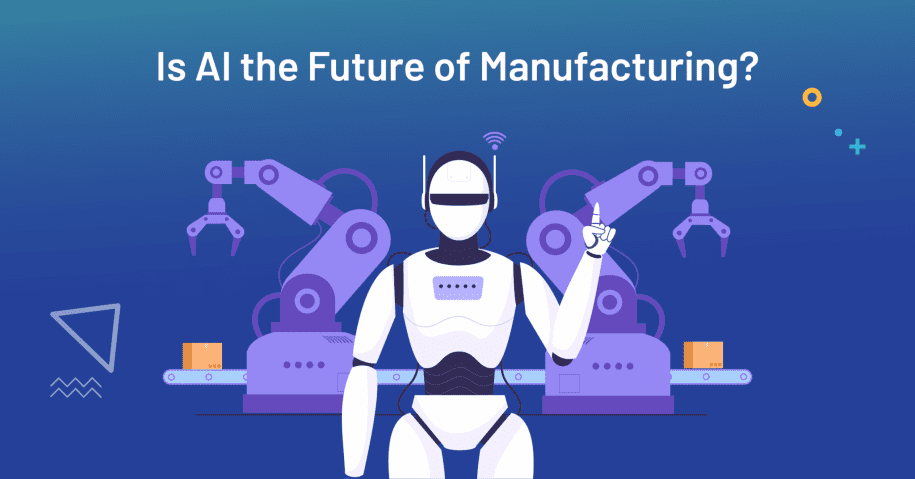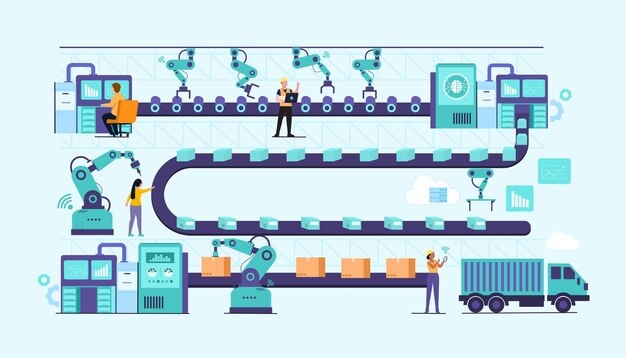Since the advent of the internet, the world’s highest-performing factories have been digitised. Today, terabytes of data flow empower organisations with a plethora of information that is becoming increasingly difficult to handle, leading to additional costs and mitigated efficiency.
For this reason, AI is needed in the manufacturing industry. Artificial Intelligence and machine learning provide manufacturers with unprecedented opportunities to optimise supply chains, increase throughput and accelerate research and development. According to the Manufacturer’s 2018 report, smart factory technology and AI methodology will increase the productivity of 92% of senior manufacturing employees.
More than half of the manufacturing businesses are looking for AI solutions to use in the manufacturing industry, but only 12% apply them. This is where the problem lies. If AI is enabled appropriately in organisations, it can enhance labour productivity by 40%. Also, it has been forecasted that AI can enhance $3.8 trillion in GVA to manufacturing in 2035, a straight jump of 45% compared to a regular manufacturing business.
What is the Driving Force for Adopting Transformative AI in the Manufacturing Industry?
Some of the biggest benefits are:
- High sales volatility
- Need to find continuous cost savings
- Short production times
- Compliance/increased regulation and inspection
- Factory floor learning and adaptability
- Manufacturing capacity and supply chain requirements
- Low volume and/or customised products
- Detect defects
- Use predictive maintenance to reduce downtime
- Respond to changes in demand throughout the supply chain in real-time
- Reduce the cost of small or single lot products and allow for more customization
- Improve employee satisfaction by offloading mundane tasks to your machine
Key AI Use-cases in Manufacturing
1. Anamoly Detection
Today, many assembly lines lack the systems and technologies needed to identify errors across the production line. Even those that may exist are very simple and require a skilled engineer to create and hard-code an algorithm to distinguish between a running and a defective component. Most of these systems cannot yet learn or integrate new information, resulting in a myriad of false alarms that field employees need to check manually. By equipping this system with Artificial Intelligence and self-learning capabilities, manufacturers can significantly reduce the time required for false alarms and quality control.
2. Predictive Maintenance
Predictive maintenance using Artificial Intelligence in manufacturing is a great way that helps organisations to predict how and when any machine maintenance is required. This feature of AI reduces the chances of unplanned downtime through ML. Machine problems are effectively and quickly resolved with the help of the latest AI-based technologies such as advanced analytics and sensors that are built into the manufacturing equipment. This makes it much easier to respond to alerts and resolve issues pertaining to machines.
3. Digital Twin
A digital twin is a representation (virtual) of a product, factory, or service. This simulation duplicates the characteristics of its real counterparts in the form of cameras, sensors and other methods related to data acquisition. It is an amalgamation of virtual and real worlds that enables data analysis and system monitoring, prevents machine-related issues before they occur, prevents downtime, develops new possibilities and uses simulation for the future.
4. Integration of Assembly Lines
Today, many devices used by manufacturers send large amounts of data to the cloud. Unfortunately, this information is usually isolated and does not work well. To get a complete picture of your operations, several different dashboards and subject matter experts need to understand everything. You can be confident that you will have a view of your operations by creating an integrated app that retrieves data from a wide range of IoT-connected devices.
5. Assembly Line Optimization
By incorporating Artificial Intelligence into the IoT ecosystem, this wealth of data can be used to create a variety of automation. For example, if the equipment operator shows signs of fatigue, the supervisor will be notified. In the event of a device failure, the system can automatically trigger an emergency response plan.
6. Prediction of Failure Mode
Despite the visual inspection, the product can fail in many ways – in fact, any product that is given the go-ahead can break down, or a product that has been rejected can work great. A manual bias exists, and there could be a difference in the way people look at and judge bugs and objects. There is a massive amount of data on how the manufactured products should be tested and verified. AI in this field can predict failure and identify areas that need more testing, thus eliminating all rejections and anomalies in the manufacturing process.
7. Generative design
AI used for manufacturing processes helps companies develop their products. The mechanism is as follows – the designer or engineer feeds the design goals to the generative design algorithm. These algorithms then examine all possible sequences in the solution and generate alternate designs. Finally, use machine learning to test and improve each iteration.
8. Compliance and quality assurance
Manufacturing requires meticulous attention to detail, and that need is exacerbated only in the electronics arena. AI-enabled technology can help manufacturers observe the defects very minutely, giving them a chance to instantly make corrections. The manufacturer can take pictures of the defects and send them for further verification, but this entire process is automated with AI and ML. All you need is an effective automated visual inspection or verification tool that can find even the smallest defects in a product. The systems detect defects, mark them and send a warning.
9. Environmental impact
The manufacturing process, including electronic devices, is notorious for harming the environment. The manufacturing of lithium-ion batteries results in an incessant extraction of cobalt, nickel and graphite; there is enhanced production of plastics, the never-ending want and demand for energy, abundant waste products, etc., that are harming our planet more than ever. AI optimises energy efficiency and supports the development of new green materials that are conducive to the environment. Google is already using AI in its data centres.
10. Price forecast
To create a product, you initially need to buy the resources you need. Due to the invariable and unpredictable fluctuations in prices, it can be challenging to determine the right time to purchase a resource. It becomes equally important to estimate the cost of the manufactured product before it leaves the factory. You can provide accurate pricing recommendations using AI as you would for pricing.
11. Customer service
In the manufacturing industry, the relevance of customer service is often ignored. This is a blunder. If you lose a customer, it would mean that you as a manufacturer lose credibility, profits, sales and ROI. AI solutions can analyse customer behaviour by predicting the outcomes and identifying consumer patterns. By observing actual customer behaviour, companies can better respond to their needs. AI empowers the capabilities of the manufacturing unit that enable service providers, IT and engineering organisations to consistently deliver personalised and excellent customer experiences.
Conclusion
Artificial Intelligence is a breakthrough technology in the manufacturing industry. As technology develops and costs go down, AI becomes more acceptable and readily available to businesses. The adoption of AI has enabled the industry to make faster decisions driven by data, reduce operating costs, enhance manufacturing processes and optimise customer service. It is a misconception that manufacturing will totally depend on AI or machines. Instead, AI is now an extension of the human workforce, not a replacement for human intelligence.




Leave a Reply